Home / Transesterification
Carboxylic Acid Derivatives
Transesterification
Last updated: March 26th, 2025 |
Transesterification of Esters
- Conversion of one ester into another ester via exchange of -OR groups is called transesterification
- Transesterification can be performed under basic or acidic conditions
- Under basic conditions, transesterification occurs via a two-step addition-elimination mechanism
- Intramolecular transesterification results in the formation of cyclic esters (lactones)
- Under acidic conditions, transesterification follows the PADPED pattern (protonation-addition-deprotonation-protonation-elimination-deprotonation)
- Watch out for transesterification as a side-reaction in the course of other reactions involving alkoxide bases (e.g. the Claisen condensation)
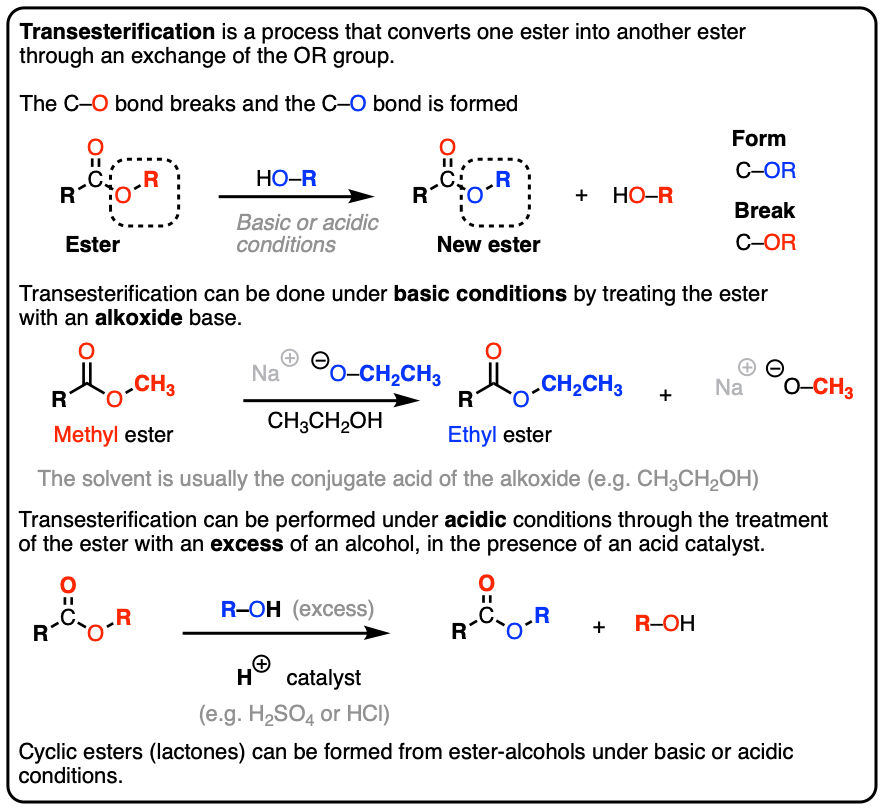
Table of Contents
1. Transesterification
What is transesterification? It’s the conversion of one ester into another through exchange of -OR groups.
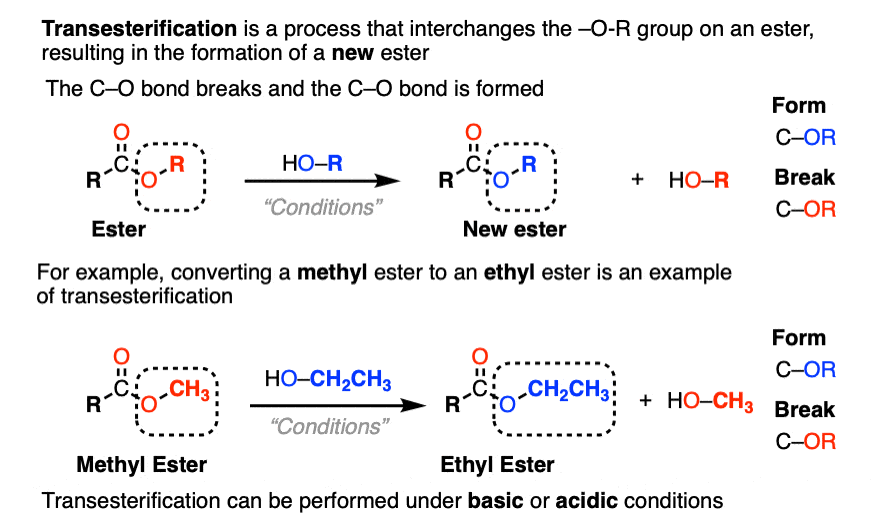
There are two sets of conditions for transesterification. It can be done under basic conditions or under acidic conditions.
2. Transesterification Under Basic Conditions
Transesterification under basic conditions can be achieved through adding an alkoxide to an ester.
In this example, adding sodium ethoxide (NaOCH2CH3) to this methyl ester results in formation of the ethyl ester, giving off sodium methoxide as the leaving group.
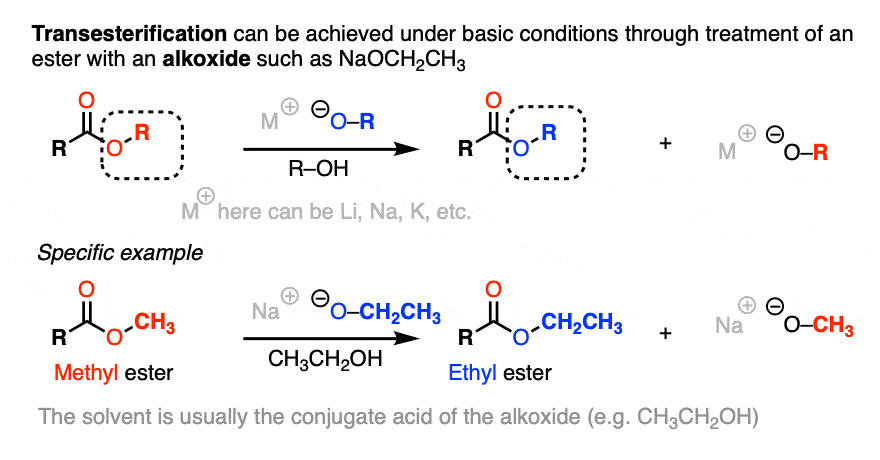
The usual choice of solvent for transesterification is the conjugate acid of the alkoxide (i.e. ethanol in this case). Note 1.
The mechanism for transesterification under basic conditions is fairly straightforward if you’ve covered nucleophilic acyl substitution; it proceeds through a two step addition-elimination mechanism. (See post: Nucleophilic Acyl Substitution)
In the first step, a nucleophilic alkoxide ion performs nucleophilic addition upon the ester. This results in a tetrahedral intermediate, which then undergoes elimination of the RO(-) group of the starting ester to give the final ester.
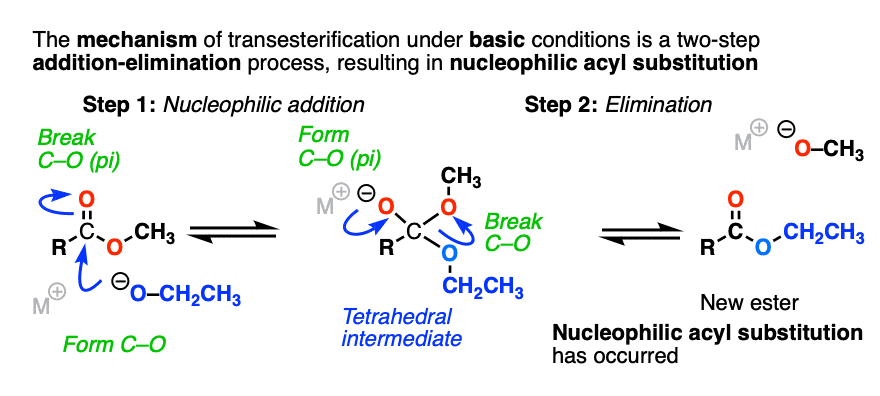
For many, this explanation will be sufficient. However, if you’re wondering how to get this reaction to favor one direction versus the other, see Note 1.
3. Intramolecular Transesterification
One interesting application of base-catalyzed transesterification is in the formation of lactones from ester-alcohols.
This usually requires a base, as the neutral alcohol is generally not nucleophilic enough by itself to promote this reaction.
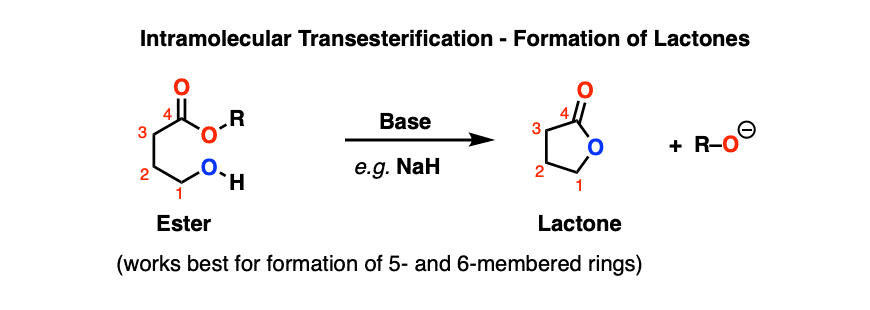
For these purposes, it’s often useful to employ a base that won’t react with the carbonyl group of our final product (and in so doing cause another transesterification).
An excellent choice of base here is hydride ion (H-), in the form of sodium hydride (NaH) or potassium hydride (KH).
Hydride ion deprotonates OH to give the alkoxide and hydrogen gas (H2), which bubbles away and can no longer participate in any reactions. The alkoxide then acts as a nucleophile to form the lactone through the two-step addition-elimination mechanism.
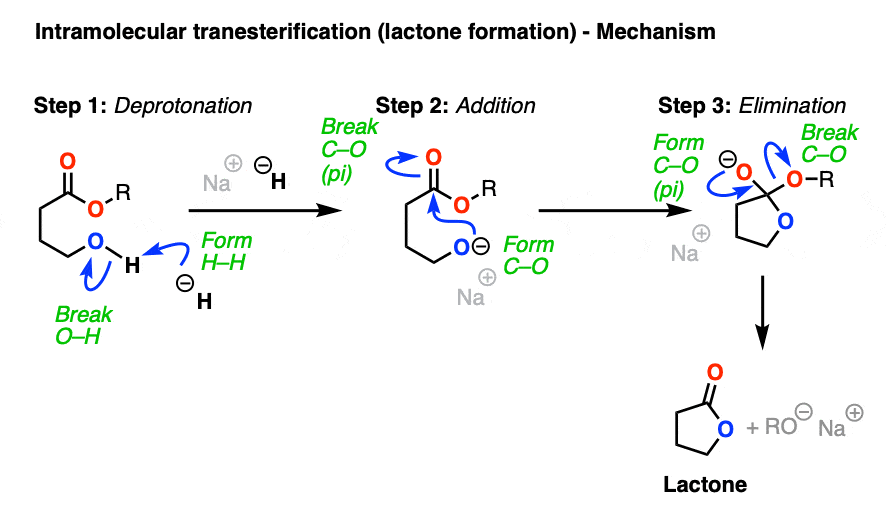
Generally speaking the formation of five- and six-membered rings is favored relative to opening of the ring, for reasons related to entropy. [Note 2]
4. Transesterification Under Acidic Conditions
It’s also possible to perform transesterification under acidic conditions.

Here are two examples.
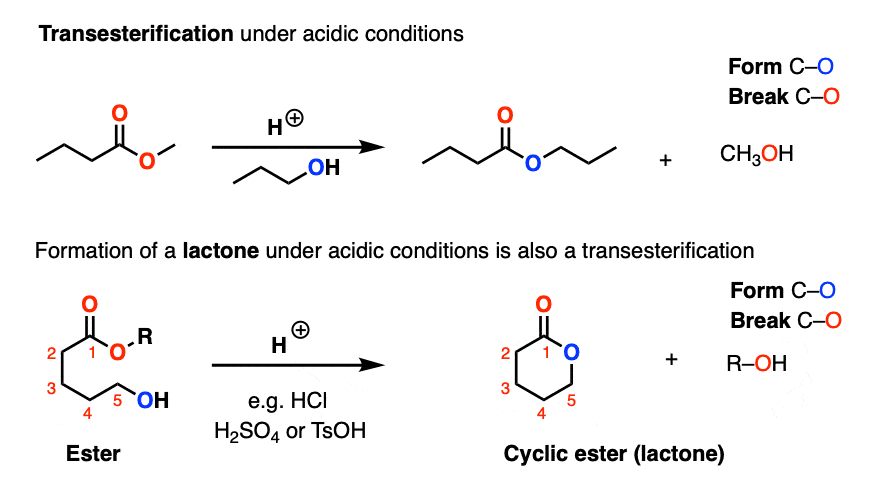
Note that this reaction can also be used in an intramolecular fashion to give cyclic esters (lactones).
In order to get the reaction to proceed in a desired direction, it helps to use the alcohol nucleophile as the solvent.
- For example, to make the ethyl ester from a methyl ester, use ethanol as solvent.
- To achieve the reverse transformation, use methanol.
5. Acidic Transesterification – Mechanism
So how does this reaction work?
Good news – it’s essentially the same mechanism as the Fischer esterification reaction, except our leaving group is ROH instead of H2O.
As you may recall, the mechanism for the Fischer esterification is PADPED. So is the mechanism for a great deal of other reactions (See post: Making Music With Mechanisms)
If you’re unfamiliar, PADPED stands for
- Protonation (of the ester carbonyl oxygen)
- Addition (of alcohol to the carbonyl)
- Deprotonation (of the alcohol)
- Protonation (of the alcohol that is going to leave)
- Elimination (of the alcohol leaving group)
- Deprotonation (of the carbonyl).
Here is the mechanism:
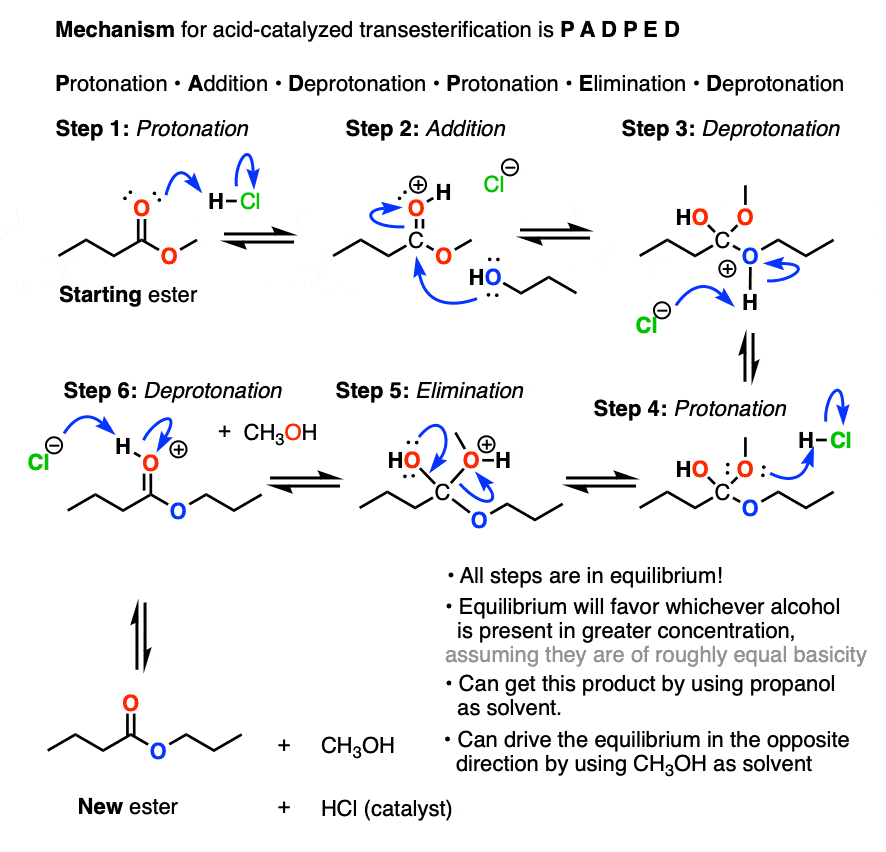
The reaction begins with protonation of the carbonyl by the acid catalyst [Note 3] (Step 1, form O-H) which makes the carbonyl carbon into a better electrophile (See post: Nucleophilic Addition to Carbonyls).
In the next step, the alcohol attacks the carbonyl to give a tetrahedral intermediate (Step 2, form C-O, break C-O (pi)) which is then deprotonated (Step 3, break O-H) and then protonated on the other oxygen (Step 4, form O-H).
Since the conjugate acid is a better leaving group, this group then undergoes elimination (Step 5, form C-O (pi) break C-O) to give the protonated (new) ester, which then undergoes a final deprotonation (Step 6, break O-H) to give the new ester.
All of these steps are in equilibrium.
Since most aliphatic alcohols are of comparable acidity, there is no strong driving force for this reaction unless one uses a large excess of alcohol (i.e. if we use it as the solvent). [Note 4].
6. Summary
One of the important reasons to learn about transesterification is just to be aware that it can happen in the context of other reactions.
For example, in the Claisen condensation (See post: Claisen and Dieckmann Condensations) if we choose our base unwisely, we may end up peforming nucleophilic acyl substitution in addition to doing our Claisen!
To summarize:
- Transesterification is the conversion of one ester to another via exchange of the alkoxy (OR) groups.
- It can be performed under both basic and acidic conditions.
- The mechanism under basic conditions is a two-step addition-elimination sequence.
- Under acidic conditions, the mechanism is PADPED (Protonation-Addition-Deprotonation-Protonation-Elimination-Deprotonation).
- Be on the lookout for intramolecular transesterifications (lactone formation)
- Also, be alert to the possibility for transesterifications under basic conditions in the context of other reactions (e.g. enolate formation with RO(-) ).
Notes
Related Articles
- Nucleophilic Addition To Carbonyls
- Nucleophilic Acyl Substitution (With Negatively Charged Nucleophiles)
- Making Music With Mechanisms (PADPED)
- What makes a good leaving group?
- How to Use a pKa Table
- Acid Base Reactions Are Fast
- Transesterification promoted by alkoxides (MOC Membership)
- Proton Transfer
- Basic Hydrolysis of Esters – Saponification
Note 1. One detail of this reaction may be unsatisfying to some, so let’s use this footnote to go into more detail.
Nucleophilic acyl substitution reactions with basic nucleophiles tend to be favored in the direction whereby the leaving group is a weaker base than the nucleophile. (See post: How to Use a pKa Table)
However, if the two alkoxides (the nucleophile and leaving group) are of comparable basicity, then there won’t be a significant driving force for the reaction based on basicity alone.
For example, the conjugate bases of ethanol (pKa 15.9) and methanol (pKa 15.5) have extremely similar basicities, meaning they have similar leaving group abilities. (See post: What Makes a Good Leaving Group?)
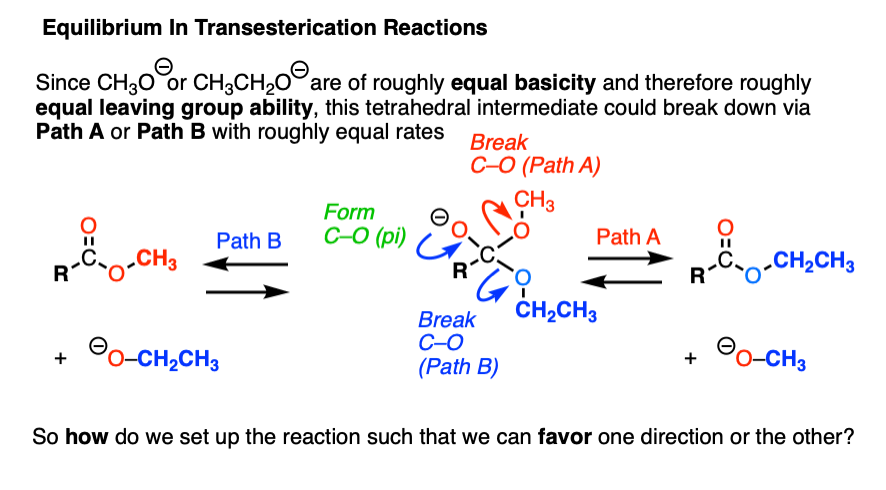
The question becomes: how do you get the reaction to favor one direction or the other?
There are two ways to ensure that the mechanism favors the desired product.
One way is to use the conjugate acid of the alkoxide as the solvent.
Let’s say we want to substitute CH3CH2O– for CH3O–. We should use CH3CH2OH as our solvent.
This means there will be a large excess of CH3CH2OH relative to the alkoxide leaving group CH3O(-).
Acid-base reactions are fast. (See post: Acid-Base Reactions Are Fast). So as soon as that CH3O(-) is formed, it undergoes an acid-base reaction with the solvent CH3CH2OH . Even though they are of comparable acidity, equilibrium will greatly favor formation of CH3CH2O(-) since the concentration of CH3CH2OH is several orders of magnitude higher than the concentration of CH3OH.
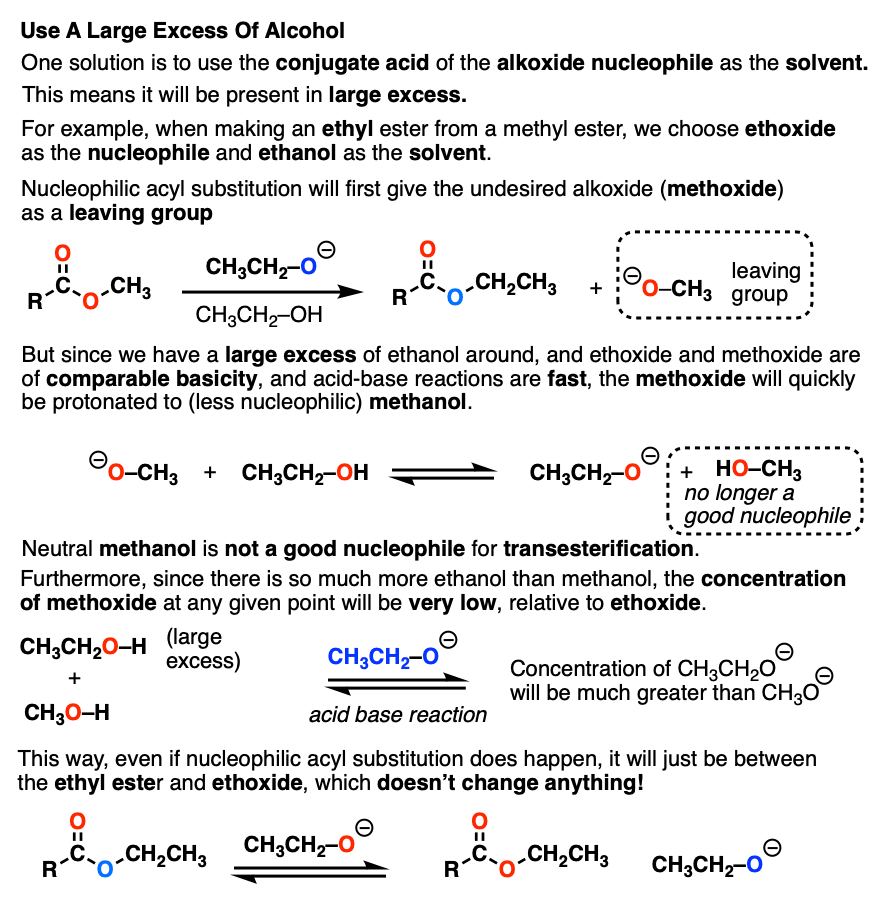
The other way is to use a large excess (e.g. 5-10 equivalents at least) of the alkoxide nucleophile.
This will push the equilibrium towards the desired product; in this case it’s advisable to avoid using an alcoholic solvent, since it could result in the solvent alkoxide acting as the nucleophile and resulting in mixtures of esters.
Note 2. There is a slight entropic preference for ring formation.
Note 3. When HCl is added to an alcohol, it will immediately protonate the alcohol to give the conjugate acid of the alcohol (e.g. CH3OH2(+) Cl(-) ) but HCl is drawn here for simplicity.
Note 4. Aromatic alcohols (e.g. phenol) are usually not very good candidates as nucleophiles for transesterification reactions. Besides the fact that phenol is a solid (and can’t be used as solvent) strong acid will protonate the aromatic ring.
Quiz Yourself!
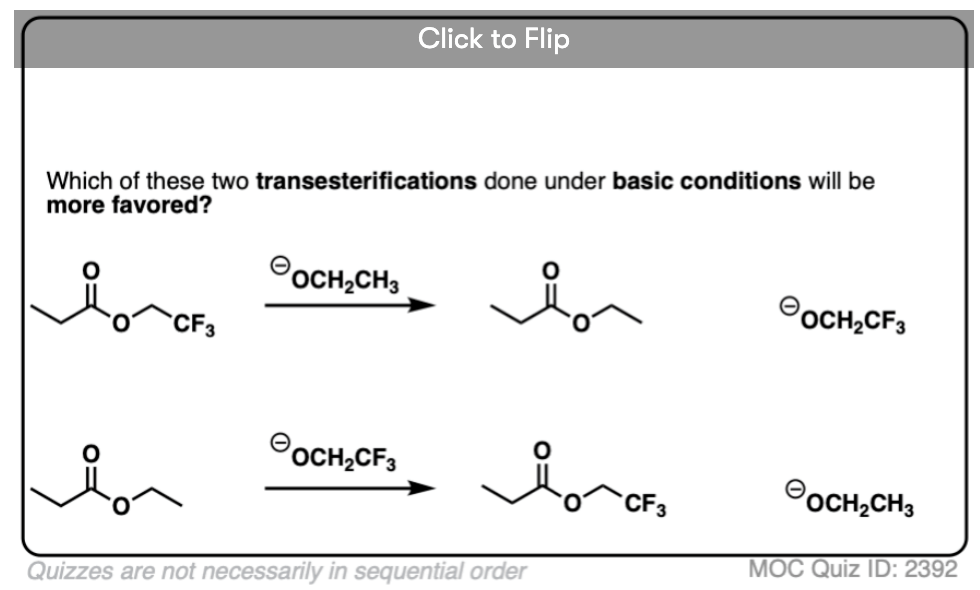
Become a MOC member to see the clickable quiz with answers on the back.
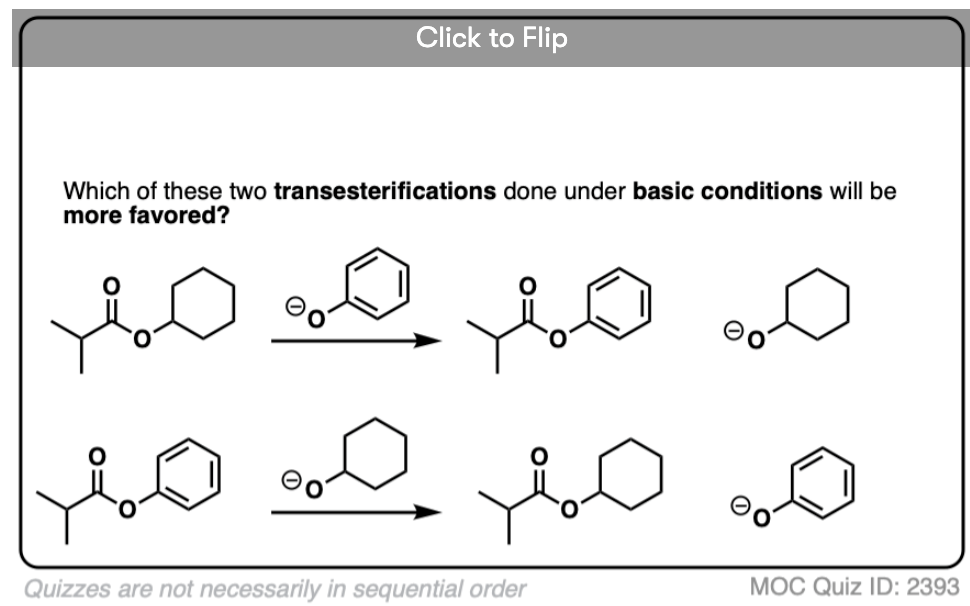
Become a MOC member to see the clickable quiz with answers on the back.
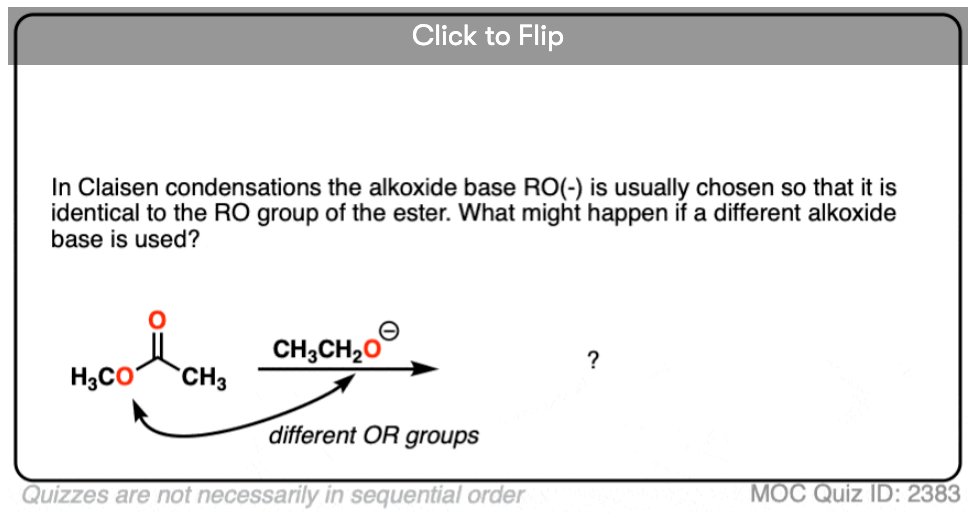
Become a MOC member to see the clickable quiz with answers on the back.
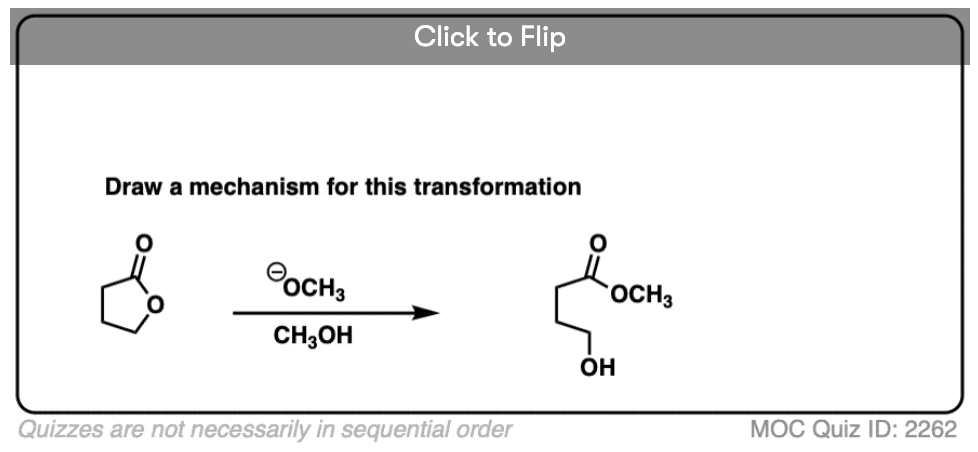
Become a MOC member to see the clickable quiz with answers on the back.
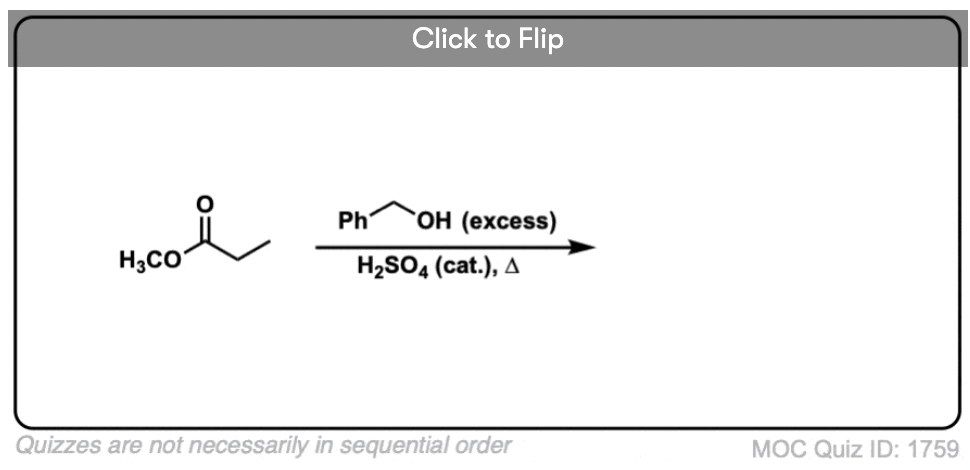
Become a MOC member to see the clickable quiz with answers on the back.
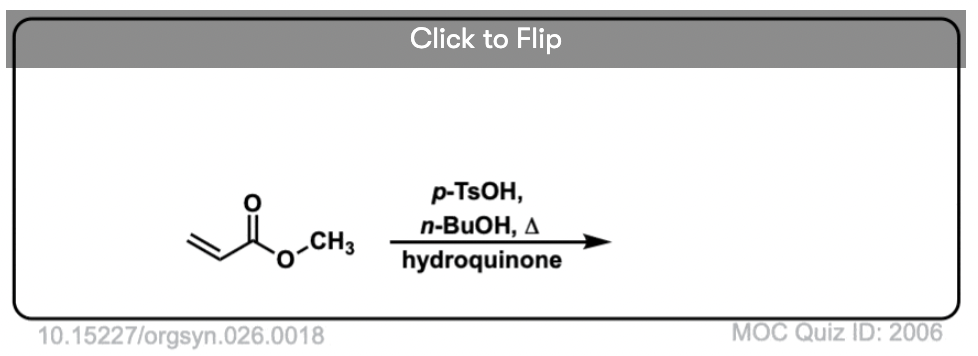
Become a MOC member to see the clickable quiz with answers on the back.
(Advanced) References and Further Reading
The interchange of alkoxy groups in esters can be carried out with acidic or basic catalysis, and follows a similar mechanism as hydrolysis. This is an equilibrium process which is driven to completion by using a large excess of the alcohol (usually as the solvent, in the case of low-boiling alcohols such as methanol or ethanol).
-
- Catalysis in ester cleavage. I. Nucleophilic catalysis by acetate ion in the methanolysis of p-nitrophenyl acetate
Richard L. Schowen and Cherie Gass Behn
Journal of the American Chemical Society 1968, 90 (21), 5839-5844
DOI: 10.1021/ja01023a031
This paper uses radioactively labeled (with tritium) acetate ion to study the basic transesterification mechanism in methanol. - Catalysis in ester cleavage. II. Isotope exchange and solvolysis in the basic methanolysis of aryl esters. Molecular interpretation of free energies, enthalpies, and entropies of activation
Carl G. Mitton, Richard L. Schowen, Michael Gresser, and John Shapley
Journal of the American Chemical Society 1969, 91 (8), 2036-2044
DOI: 10.1021/ja01036a029 - Catalysis in ester cleavage. III. Solvent isotope effects and transition-state solvation in the basic methanolysis of esters
Carl G. Mitton, Michael Gresser, and Richard L. Schowen
Journal of the American Chemical Society 1969, 91 (8), 2045-2047
DOI: 10.1021/ja01036a030 - Production of Biodiesel through Base-Catalyzed Transesterification of Safflower Oil Using an Optimized Protocol
Umer Rashid and Farooq Anwar
Energy & Fuels 2008, 22 (2), 1306-1312
DOI: 10.1021/ef700548s
This is a popular application of the transesterification reaction, and is commonly used in undergraduate chemistry laboratories. Biodiesel, or fatty acid methyl esters (‘FAMEs’) can be produced through the methanolysis of naturally occurring triglycerides.
- Catalysis in ester cleavage. I. Nucleophilic catalysis by acetate ion in the methanolysis of p-nitrophenyl acetate
00 General Chemistry Review
01 Bonding, Structure, and Resonance
- How Do We Know Methane (CH4) Is Tetrahedral?
- Hybrid Orbitals and Hybridization
- How To Determine Hybridization: A Shortcut
- Orbital Hybridization And Bond Strengths
- Sigma bonds come in six varieties: Pi bonds come in one
- A Key Skill: How to Calculate Formal Charge
- The Four Intermolecular Forces and How They Affect Boiling Points
- 3 Trends That Affect Boiling Points
- How To Use Electronegativity To Determine Electron Density (and why NOT to trust formal charge)
- Introduction to Resonance
- How To Use Curved Arrows To Interchange Resonance Forms
- Evaluating Resonance Forms (1) - The Rule of Least Charges
- How To Find The Best Resonance Structure By Applying Electronegativity
- Evaluating Resonance Structures With Negative Charges
- Evaluating Resonance Structures With Positive Charge
- Exploring Resonance: Pi-Donation
- Exploring Resonance: Pi-acceptors
- In Summary: Evaluating Resonance Structures
- Drawing Resonance Structures: 3 Common Mistakes To Avoid
- How to apply electronegativity and resonance to understand reactivity
- Bond Hybridization Practice
- Structure and Bonding Practice Quizzes
- Resonance Structures Practice
02 Acid Base Reactions
- Introduction to Acid-Base Reactions
- Acid Base Reactions In Organic Chemistry
- The Stronger The Acid, The Weaker The Conjugate Base
- Walkthrough of Acid-Base Reactions (3) - Acidity Trends
- Five Key Factors That Influence Acidity
- Acid-Base Reactions: Introducing Ka and pKa
- How to Use a pKa Table
- The pKa Table Is Your Friend
- A Handy Rule of Thumb for Acid-Base Reactions
- Acid Base Reactions Are Fast
- pKa Values Span 60 Orders Of Magnitude
- How Protonation and Deprotonation Affect Reactivity
- Acid Base Practice Problems
03 Alkanes and Nomenclature
- Meet the (Most Important) Functional Groups
- Condensed Formulas: Deciphering What the Brackets Mean
- Hidden Hydrogens, Hidden Lone Pairs, Hidden Counterions
- Don't Be Futyl, Learn The Butyls
- Primary, Secondary, Tertiary, Quaternary In Organic Chemistry
- Branching, and Its Affect On Melting and Boiling Points
- The Many, Many Ways of Drawing Butane
- Wedge And Dash Convention For Tetrahedral Carbon
- Common Mistakes in Organic Chemistry: Pentavalent Carbon
- Table of Functional Group Priorities for Nomenclature
- Summary Sheet - Alkane Nomenclature
- Organic Chemistry IUPAC Nomenclature Demystified With A Simple Puzzle Piece Approach
- Boiling Point Quizzes
- Organic Chemistry Nomenclature Quizzes
04 Conformations and Cycloalkanes
- Staggered vs Eclipsed Conformations of Ethane
- Conformational Isomers of Propane
- Newman Projection of Butane (and Gauche Conformation)
- Introduction to Cycloalkanes
- Geometric Isomers In Small Rings: Cis And Trans Cycloalkanes
- Calculation of Ring Strain In Cycloalkanes
- Cycloalkanes - Ring Strain In Cyclopropane And Cyclobutane
- Cyclohexane Conformations
- Cyclohexane Chair Conformation: An Aerial Tour
- How To Draw The Cyclohexane Chair Conformation
- The Cyclohexane Chair Flip
- The Cyclohexane Chair Flip - Energy Diagram
- Substituted Cyclohexanes - Axial vs Equatorial
- Ranking The Bulkiness Of Substituents On Cyclohexanes: "A-Values"
- Cyclohexane Chair Conformation Stability: Which One Is Lower Energy?
- Fused Rings - Cis-Decalin and Trans-Decalin
- Naming Bicyclic Compounds - Fused, Bridged, and Spiro
- Bredt's Rule (And Summary of Cycloalkanes)
- Newman Projection Practice
- Cycloalkanes Practice Problems
05 A Primer On Organic Reactions
- The Most Important Question To Ask When Learning a New Reaction
- Curved Arrows (for reactions)
- Nucleophiles and Electrophiles
- The Three Classes of Nucleophiles
- Nucleophilicity vs. Basicity
- What Makes A Good Nucleophile?
- What Makes A Good Leaving Group?
- 3 Factors That Stabilize Carbocations
- Equilibrium and Energy Relationships
- 7 Factors that stabilize negative charge in organic chemistry
- 7 Factors That Stabilize Positive Charge in Organic Chemistry
- What's a Transition State?
- Hammond's Postulate
- Learning Organic Chemistry Reactions: A Checklist (PDF)
- Introduction to Oxidative Cleavage Reactions
06 Free Radical Reactions
- Free Radical Reactions
- 3 Factors That Stabilize Free Radicals
- Bond Strengths And Radical Stability
- Free Radical Initiation: Why Is "Light" Or "Heat" Required?
- Initiation, Propagation, Termination
- Monochlorination Products Of Propane, Pentane, And Other Alkanes
- Selectivity In Free Radical Reactions
- Selectivity in Free Radical Reactions: Bromination vs. Chlorination
- Halogenation At Tiffany's
- Allylic Bromination
- Bonus Topic: Allylic Rearrangements
- In Summary: Free Radicals
- Synthesis (2) - Reactions of Alkanes
- Free Radicals Practice Quizzes
07 Stereochemistry and Chirality
- Types of Isomers: Constitutional Isomers, Stereoisomers, Enantiomers, and Diastereomers
- How To Draw The Enantiomer Of A Chiral Molecule
- How To Draw A Bond Rotation
- Introduction to Assigning (R) and (S): The Cahn-Ingold-Prelog Rules
- Assigning Cahn-Ingold-Prelog (CIP) Priorities (2) - The Method of Dots
- Enantiomers vs Diastereomers vs The Same? Two Methods For Solving Problems
- Assigning R/S To Newman Projections (And Converting Newman To Line Diagrams)
- How To Determine R and S Configurations On A Fischer Projection
- The Meso Trap
- Optical Rotation, Optical Activity, and Specific Rotation
- Optical Purity and Enantiomeric Excess
- What's a Racemic Mixture?
- Chiral Allenes And Chiral Axes
- Stereochemistry Practice Problems and Quizzes
08 Substitution Reactions
- Nucleophilic Substitution Reactions - Introduction
- Two Types of Nucleophilic Substitution Reactions
- The SN2 Mechanism
- Why the SN2 Reaction Is Powerful
- The SN1 Mechanism
- The Conjugate Acid Is A Better Leaving Group
- Comparing the SN1 and SN2 Reactions
- Polar Protic? Polar Aprotic? Nonpolar? All About Solvents
- Steric Hindrance is Like a Fat Goalie
- Common Blind Spot: Intramolecular Reactions
- Substitution Practice - SN1
- Substitution Practice - SN2
09 Elimination Reactions
- Elimination Reactions (1): Introduction And The Key Pattern
- Elimination Reactions (2): The Zaitsev Rule
- Elimination Reactions Are Favored By Heat
- Two Elimination Reaction Patterns
- The E1 Reaction
- The E2 Mechanism
- E1 vs E2: Comparing the E1 and E2 Reactions
- Antiperiplanar Relationships: The E2 Reaction and Cyclohexane Rings
- Bulky Bases in Elimination Reactions
- Comparing the E1 vs SN1 Reactions
- Elimination (E1) Reactions With Rearrangements
- E1cB - Elimination (Unimolecular) Conjugate Base
- Elimination (E1) Practice Problems And Solutions
- Elimination (E2) Practice Problems and Solutions
10 Rearrangements
11 SN1/SN2/E1/E2 Decision
- Identifying Where Substitution and Elimination Reactions Happen
- Deciding SN1/SN2/E1/E2 (1) - The Substrate
- Deciding SN1/SN2/E1/E2 (2) - The Nucleophile/Base
- SN1 vs E1 and SN2 vs E2 : The Temperature
- Deciding SN1/SN2/E1/E2 - The Solvent
- Wrapup: The Key Factors For Determining SN1/SN2/E1/E2
- Alkyl Halide Reaction Map And Summary
- SN1 SN2 E1 E2 Practice Problems
12 Alkene Reactions
- E and Z Notation For Alkenes (+ Cis/Trans)
- Alkene Stability
- Alkene Addition Reactions: "Regioselectivity" and "Stereoselectivity" (Syn/Anti)
- Stereoselective and Stereospecific Reactions
- Hydrohalogenation of Alkenes and Markovnikov's Rule
- Hydration of Alkenes With Aqueous Acid
- Rearrangements in Alkene Addition Reactions
- Halogenation of Alkenes and Halohydrin Formation
- Oxymercuration Demercuration of Alkenes
- Hydroboration Oxidation of Alkenes
- m-CPBA (meta-chloroperoxybenzoic acid)
- OsO4 (Osmium Tetroxide) for Dihydroxylation of Alkenes
- Palladium on Carbon (Pd/C) for Catalytic Hydrogenation of Alkenes
- Cyclopropanation of Alkenes
- A Fourth Alkene Addition Pattern - Free Radical Addition
- Alkene Reactions: Ozonolysis
- Summary: Three Key Families Of Alkene Reaction Mechanisms
- Synthesis (4) - Alkene Reaction Map, Including Alkyl Halide Reactions
- Alkene Reactions Practice Problems
13 Alkyne Reactions
- Acetylides from Alkynes, And Substitution Reactions of Acetylides
- Partial Reduction of Alkynes With Lindlar's Catalyst
- Partial Reduction of Alkynes With Na/NH3 To Obtain Trans Alkenes
- Alkyne Hydroboration With "R2BH"
- Hydration and Oxymercuration of Alkynes
- Hydrohalogenation of Alkynes
- Alkyne Halogenation: Bromination and Chlorination of Alkynes
- Oxidation of Alkynes With O3 and KMnO4
- Alkenes To Alkynes Via Halogenation And Elimination Reactions
- Alkynes Are A Blank Canvas
- Synthesis (5) - Reactions of Alkynes
- Alkyne Reactions Practice Problems With Answers
14 Alcohols, Epoxides and Ethers
- Alcohols - Nomenclature and Properties
- Alcohols Can Act As Acids Or Bases (And Why It Matters)
- Alcohols - Acidity and Basicity
- The Williamson Ether Synthesis
- Ethers From Alkenes, Tertiary Alkyl Halides and Alkoxymercuration
- Alcohols To Ethers via Acid Catalysis
- Cleavage Of Ethers With Acid
- Epoxides - The Outlier Of The Ether Family
- Opening of Epoxides With Acid
- Epoxide Ring Opening With Base
- Making Alkyl Halides From Alcohols
- Tosylates And Mesylates
- PBr3 and SOCl2
- Elimination Reactions of Alcohols
- Elimination of Alcohols To Alkenes With POCl3
- Alcohol Oxidation: "Strong" and "Weak" Oxidants
- Demystifying The Mechanisms of Alcohol Oxidations
- Protecting Groups For Alcohols
- Thiols And Thioethers
- Calculating the oxidation state of a carbon
- Oxidation and Reduction in Organic Chemistry
- Oxidation Ladders
- SOCl2 Mechanism For Alcohols To Alkyl Halides: SN2 versus SNi
- Alcohol Reactions Roadmap (PDF)
- Alcohol Reaction Practice Problems
- Epoxide Reaction Quizzes
- Oxidation and Reduction Practice Quizzes
15 Organometallics
- What's An Organometallic?
- Formation of Grignard and Organolithium Reagents
- Organometallics Are Strong Bases
- Reactions of Grignard Reagents
- Protecting Groups In Grignard Reactions
- Synthesis Problems Involving Grignard Reagents
- Grignard Reactions And Synthesis (2)
- Organocuprates (Gilman Reagents): How They're Made
- Gilman Reagents (Organocuprates): What They're Used For
- The Heck, Suzuki, and Olefin Metathesis Reactions (And Why They Don't Belong In Most Introductory Organic Chemistry Courses)
- Reaction Map: Reactions of Organometallics
- Grignard Practice Problems
16 Spectroscopy
- Degrees of Unsaturation (or IHD, Index of Hydrogen Deficiency)
- Conjugation And Color (+ How Bleach Works)
- Introduction To UV-Vis Spectroscopy
- UV-Vis Spectroscopy: Absorbance of Carbonyls
- UV-Vis Spectroscopy: Practice Questions
- Bond Vibrations, Infrared Spectroscopy, and the "Ball and Spring" Model
- Infrared Spectroscopy: A Quick Primer On Interpreting Spectra
- IR Spectroscopy: 4 Practice Problems
- 1H NMR: How Many Signals?
- Homotopic, Enantiotopic, Diastereotopic
- Diastereotopic Protons in 1H NMR Spectroscopy: Examples
- 13-C NMR - How Many Signals
- Liquid Gold: Pheromones In Doe Urine
- Natural Product Isolation (1) - Extraction
- Natural Product Isolation (2) - Purification Techniques, An Overview
- Structure Determination Case Study: Deer Tarsal Gland Pheromone
17 Dienes and MO Theory
- What To Expect In Organic Chemistry 2
- Are these molecules conjugated?
- Conjugation And Resonance In Organic Chemistry
- Bonding And Antibonding Pi Orbitals
- Molecular Orbitals of The Allyl Cation, Allyl Radical, and Allyl Anion
- Pi Molecular Orbitals of Butadiene
- Reactions of Dienes: 1,2 and 1,4 Addition
- Thermodynamic and Kinetic Products
- More On 1,2 and 1,4 Additions To Dienes
- s-cis and s-trans
- The Diels-Alder Reaction
- Cyclic Dienes and Dienophiles in the Diels-Alder Reaction
- Stereochemistry of the Diels-Alder Reaction
- Exo vs Endo Products In The Diels Alder: How To Tell Them Apart
- HOMO and LUMO In the Diels Alder Reaction
- Why Are Endo vs Exo Products Favored in the Diels-Alder Reaction?
- Diels-Alder Reaction: Kinetic and Thermodynamic Control
- The Retro Diels-Alder Reaction
- The Intramolecular Diels Alder Reaction
- Regiochemistry In The Diels-Alder Reaction
- The Cope and Claisen Rearrangements
- Electrocyclic Reactions
- Electrocyclic Ring Opening And Closure (2) - Six (or Eight) Pi Electrons
- Diels Alder Practice Problems
- Molecular Orbital Theory Practice
18 Aromaticity
- Introduction To Aromaticity
- Rules For Aromaticity
- Huckel's Rule: What Does 4n+2 Mean?
- Aromatic, Non-Aromatic, or Antiaromatic? Some Practice Problems
- Antiaromatic Compounds and Antiaromaticity
- The Pi Molecular Orbitals of Benzene
- The Pi Molecular Orbitals of Cyclobutadiene
- Frost Circles
- Aromaticity Practice Quizzes
19 Reactions of Aromatic Molecules
- Electrophilic Aromatic Substitution: Introduction
- Activating and Deactivating Groups In Electrophilic Aromatic Substitution
- Electrophilic Aromatic Substitution - The Mechanism
- Ortho-, Para- and Meta- Directors in Electrophilic Aromatic Substitution
- Understanding Ortho, Para, and Meta Directors
- Why are halogens ortho- para- directors?
- Disubstituted Benzenes: The Strongest Electron-Donor "Wins"
- Electrophilic Aromatic Substitutions (1) - Halogenation of Benzene
- Electrophilic Aromatic Substitutions (2) - Nitration and Sulfonation
- EAS Reactions (3) - Friedel-Crafts Acylation and Friedel-Crafts Alkylation
- Intramolecular Friedel-Crafts Reactions
- Nucleophilic Aromatic Substitution (NAS)
- Nucleophilic Aromatic Substitution (2) - The Benzyne Mechanism
- Reactions on the "Benzylic" Carbon: Bromination And Oxidation
- The Wolff-Kishner, Clemmensen, And Other Carbonyl Reductions
- More Reactions on the Aromatic Sidechain: Reduction of Nitro Groups and the Baeyer Villiger
- Aromatic Synthesis (1) - "Order Of Operations"
- Synthesis of Benzene Derivatives (2) - Polarity Reversal
- Aromatic Synthesis (3) - Sulfonyl Blocking Groups
- Birch Reduction
- Synthesis (7): Reaction Map of Benzene and Related Aromatic Compounds
- Aromatic Reactions and Synthesis Practice
- Electrophilic Aromatic Substitution Practice Problems
20 Aldehydes and Ketones
- What's The Alpha Carbon In Carbonyl Compounds?
- Nucleophilic Addition To Carbonyls
- Aldehydes and Ketones: 14 Reactions With The Same Mechanism
- Sodium Borohydride (NaBH4) Reduction of Aldehydes and Ketones
- Grignard Reagents For Addition To Aldehydes and Ketones
- Wittig Reaction
- Hydrates, Hemiacetals, and Acetals
- Imines - Properties, Formation, Reactions, and Mechanisms
- All About Enamines
- Breaking Down Carbonyl Reaction Mechanisms: Reactions of Anionic Nucleophiles (Part 2)
- Aldehydes Ketones Reaction Practice
21 Carboxylic Acid Derivatives
- Nucleophilic Acyl Substitution (With Negatively Charged Nucleophiles)
- Addition-Elimination Mechanisms With Neutral Nucleophiles (Including Acid Catalysis)
- Basic Hydrolysis of Esters - Saponification
- Transesterification
- Proton Transfer
- Fischer Esterification - Carboxylic Acid to Ester Under Acidic Conditions
- Lithium Aluminum Hydride (LiAlH4) For Reduction of Carboxylic Acid Derivatives
- LiAlH[Ot-Bu]3 For The Reduction of Acid Halides To Aldehydes
- Di-isobutyl Aluminum Hydride (DIBAL) For The Partial Reduction of Esters and Nitriles
- Amide Hydrolysis
- Thionyl Chloride (SOCl2) And Conversion of Carboxylic Acids to Acid Halides
- Diazomethane (CH2N2)
- Carbonyl Chemistry: Learn Six Mechanisms For the Price Of One
- Making Music With Mechanisms (PADPED)
- Carboxylic Acid Derivatives Practice Questions
22 Enols and Enolates
- Keto-Enol Tautomerism
- Enolates - Formation, Stability, and Simple Reactions
- Kinetic Versus Thermodynamic Enolates
- Aldol Addition and Condensation Reactions
- Reactions of Enols - Acid-Catalyzed Aldol, Halogenation, and Mannich Reactions
- Claisen Condensation and Dieckmann Condensation
- Decarboxylation
- The Malonic Ester and Acetoacetic Ester Synthesis
- The Michael Addition Reaction and Conjugate Addition
- The Robinson Annulation
- Haloform Reaction
- The Hell–Volhard–Zelinsky Reaction
- Enols and Enolates Practice Quizzes
23 Amines
- The Amide Functional Group: Properties, Synthesis, and Nomenclature
- Basicity of Amines And pKaH
- 5 Key Basicity Trends of Amines
- The Mesomeric Effect And Aromatic Amines
- Nucleophilicity of Amines
- Alkylation of Amines (Sucks!)
- Reductive Amination
- The Gabriel Synthesis
- Some Reactions of Azides
- The Hofmann Elimination
- The Hofmann and Curtius Rearrangements
- The Cope Elimination
- Protecting Groups for Amines - Carbamates
- The Strecker Synthesis of Amino Acids
- Introduction to Peptide Synthesis
- Reactions of Diazonium Salts: Sandmeyer and Related Reactions
- Amine Practice Questions
24 Carbohydrates
- D and L Notation For Sugars
- Pyranoses and Furanoses: Ring-Chain Tautomerism In Sugars
- What is Mutarotation?
- Reducing Sugars
- The Big Damn Post Of Carbohydrate-Related Chemistry Definitions
- The Haworth Projection
- Converting a Fischer Projection To A Haworth (And Vice Versa)
- Reactions of Sugars: Glycosylation and Protection
- The Ruff Degradation and Kiliani-Fischer Synthesis
- Isoelectric Points of Amino Acids (and How To Calculate Them)
- Carbohydrates Practice
- Amino Acid Quizzes
25 Fun and Miscellaneous
- A Gallery of Some Interesting Molecules From Nature
- Screw Organic Chemistry, I'm Just Going To Write About Cats
- On Cats, Part 1: Conformations and Configurations
- On Cats, Part 2: Cat Line Diagrams
- On Cats, Part 4: Enantiocats
- On Cats, Part 6: Stereocenters
- Organic Chemistry Is Shit
- The Organic Chemistry Behind "The Pill"
- Maybe they should call them, "Formal Wins" ?
- Why Do Organic Chemists Use Kilocalories?
- The Principle of Least Effort
- Organic Chemistry GIFS - Resonance Forms
- Reproducibility In Organic Chemistry
- What Holds The Nucleus Together?
- How Reactions Are Like Music
- Organic Chemistry and the New MCAT
26 Organic Chemistry Tips and Tricks
- Common Mistakes: Formal Charges Can Mislead
- Partial Charges Give Clues About Electron Flow
- Draw The Ugly Version First
- Organic Chemistry Study Tips: Learn the Trends
- The 8 Types of Arrows In Organic Chemistry, Explained
- Top 10 Skills To Master Before An Organic Chemistry 2 Final
- Common Mistakes with Carbonyls: Carboxylic Acids... Are Acids!
- Planning Organic Synthesis With "Reaction Maps"
- Alkene Addition Pattern #1: The "Carbocation Pathway"
- Alkene Addition Pattern #2: The "Three-Membered Ring" Pathway
- Alkene Addition Pattern #3: The "Concerted" Pathway
- Number Your Carbons!
- The 4 Major Classes of Reactions in Org 1
- How (and why) electrons flow
- Grossman's Rule
- Three Exam Tips
- A 3-Step Method For Thinking Through Synthesis Problems
- Putting It Together
- Putting Diels-Alder Products in Perspective
- The Ups and Downs of Cyclohexanes
- The Most Annoying Exceptions in Org 1 (Part 1)
- The Most Annoying Exceptions in Org 1 (Part 2)
- The Marriage May Be Bad, But the Divorce Still Costs Money
- 9 Nomenclature Conventions To Know
- Nucleophile attacks Electrophile
27 Case Studies of Successful O-Chem Students
- Success Stories: How Corina Got The The "Hard" Professor - And Got An A+ Anyway
- How Helena Aced Organic Chemistry
- From a "Drop" To B+ in Org 2 – How A Hard Working Student Turned It Around
- How Serge Aced Organic Chemistry
- Success Stories: How Zach Aced Organic Chemistry 1
- Success Stories: How Kari Went From C– to B+
- How Esther Bounced Back From a "C" To Get A's In Organic Chemistry 1 And 2
- How Tyrell Got The Highest Grade In Her Organic Chemistry Course
- This Is Why Students Use Flashcards
- Success Stories: How Stu Aced Organic Chemistry
- How John Pulled Up His Organic Chemistry Exam Grades
- Success Stories: How Nathan Aced Organic Chemistry (Without It Taking Over His Life)
- How Chris Aced Org 1 and Org 2
- Interview: How Jay Got an A+ In Organic Chemistry
- How to Do Well in Organic Chemistry: One Student's Advice
- "America's Top TA" Shares His Secrets For Teaching O-Chem
- "Organic Chemistry Is Like..." - A Few Metaphors
- How To Do Well In Organic Chemistry: Advice From A Tutor
- Guest post: "I went from being afraid of tests to actually looking forward to them".
You are most welcome!
That was very helpful! Thank you so much James!
Hi there,
If anyone can answer this question, I would be eternally grateful. This article was very helpful but I am stuck on one thing. I created biodiesel in the lab, and I used methoxide (MeO-) as the nucleophile for the transesterification reaction by combining NaOH with MeOH. I also used a large excess of just MeOH as the solvent. However, I don’t understand how the glycerol is formed in the mechanism. Is the pre-glycerol alkoxide intermediate protonated by the water that is created in the reaction between NaOH and MeOH, or is it protonated by the excess MeOH solvent that I added? Initially, I thought it must be the water since that would regenerate the -OH (catalyst from NaOH). However, Note 1 in this article makes me think it’s the excess MeOH solvent that protonates it. But this leaves me confused about the catalyst part… Can anyone explain this mechanism to me? Oleic Acid + Methanol = Methyl Esters + Glycerol using a base catalyst (NaOH + MeOH = H2O + NaOMe) and excess methanol solvent.
Hi, the acidity of methanol, water and glycerol are all very similar – within an order of magnitude of each other which in acidity terms is a very, very small difference. Any of these species can act as acids here. I don’t know your exact conditions but if you were using MeOH as solvent then its concentration will be >> the concentration of any other possible acid in solution.
If you drew MeOH as the acid you would largely be correct; it doesn’t really matter since all protons are identical anyway and there will be reverse acid-base equilibria occurring in solution between all the hydroxyl groups.
I should note that even in neutral water, the protons on H2O undergo very fast exchange with other H2O molecules. Protons are very dynamic. If you ever take an NMR spectrum of an alcohol or a carboxylic acid you will note that these peaks tend to be quite broad, which is due to their relatively fast motion compared to more static protons such as C-H that do not undergo these kinds of exchange processes.
Hope that’s helpful – James